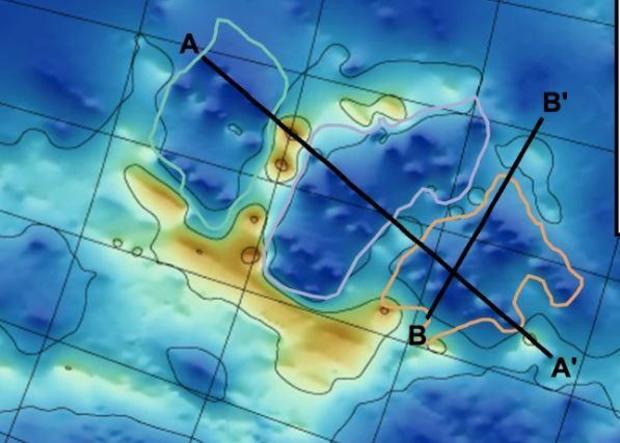Scientists discover hidden landscape "frozen in time" under Antarctic ice for millions of years
Scientists revealed Tuesday that they had discovered a vast, hidden landscape of hills and valleys carved by ancient rivers that has been "frozen in time" under the Antarctic ice for millions of years.
This landscape, which is bigger than Belgium, has remained untouched for potentially more than 34 million years, but human-driven global warming could threaten to expose it, the British and American researchers warned.
"It is an undiscovered landscape — no one's laid eyes on it," Stewart Jamieson, a glaciologist at the UK's Durham University and the lead author of the study, told AFP.
"What is exciting is that it's been hiding there in plain sight," Jamieson added, emphasizing that the researchers had not used new data, only a new approach.
The land underneath the East Antarctic Ice Sheet is less well known than the surface of Mars, Jamieson said.
The main way to "see" beneath it is for a plane overhead to send radio waves into the ice and analyze the echoes, a technique called radio-echo sounding.

But doing this across the continent — Antarctica is bigger than Europe — would pose a huge challenge.
So the researchers used existing satellite images of the surface to "trace out the valleys and ridges" more than two kilometers below, Jamieson said.
The undulating ice surface is a "ghost image" that drapes gently over these spikier features, he added.
When combined with radio-echo sounding data, an image emerged of a river-carved landscape of plunging valleys and sharply peaked hills similar to some currently on the Earth's surface.
It was like looking out the window of a long-haul flight and seeing a mountainous region below, Jamieson said, comparing the landscape to the Snowdonia area of northern Wales.
The area, stretching across 32,000 square kilometers (12,000 square miles), was once home to trees, forests and probably animals.
But then the ice came along and it was "frozen in time," Jamieson said.
Exactly when sunshine last touched this hidden world is difficult to determine, but the researchers are confident it has been at least 14 million years.
Jamieson said his "hunch" is that it was last exposed more than 34 million years ago, when Antarctica first froze over.
Some of the researchers had previously found a city-size lake under the Antarctic ice, and the team believes there are other ancient landscapes down there yet to be discovered.
Tipping point for a "runaway reaction"
The authors of the study said global warming could pose a threat to their newly discovered landscape.
"We are now on course to develop atmospheric conditions similar to those that prevailed" between 14 to 34 million years ago, when it was three to seven degrees Celsius warmer (roughly seven to 13 degrees Fahrenheit) than currently, they wrote in the journal Nature Communications.
Jamieson emphasized that the landscape is hundreds of kilometers inland from the edge of the ice, so any possible exposure would be "a long way off."
The fact that retreating ice over past warming events — such as the Pliocene period, three to 4.5 million years ago — did not expose the landscape, was cause for hope, he added.
But it remains unclear what the tipping point would be for a "runaway reaction" of melting, he said.
The study was released a day after scientists warned that the melting of the neighboring West Antarctic Ice Sheet is likely to substantially accelerate in the coming decades, even if the world meets its ambitions to limit global warming.
Earlier this year, a massive piece of Antarctica's Brunt Ice Shelf — a chunk about the size of two New York Cities — broke free.
The Brunt Ice Shelf lies across the Weddell Sea from the site of another ice shelf that's made headlines, the Larsen C ice shelf on the Antarctic Peninsula. Last year, the Larsen C ice shelf — which was roughly the size of New York City and was long considered to be stable — collapsed into the sea.
Glacier experts have warned that some of the world's bigger glaciers could disappear within a generation without a dramatic reduction in greenhouse gas emissions.
Traditionally, glacial ice builds up during the winter and provides vital water for crops, transit and millions of people on multiple continents during the summer as it slowly melts, feeding rivers.
"They make it very visible," Matthias Huss, the head of GLAMOS, an organization that monitors glaciers in Switzerland and collected the data for the academy's report, told CBS News last month. "People can really understand what is happening, with huge glaciers disappearing and shrinking. This is much more impressive than seeing another graph with rising temperatures."
- In:
- Climate Change
- Antarctica
Disclaimer: The copyright of this article belongs to the original author. Reposting this article is solely for the purpose of information dissemination and does not constitute any investment advice. If there is any infringement, please contact us immediately. We will make corrections or deletions as necessary. Thank you.
Title:Scientists discover hidden landscape "frozen in time" under Antarctic ice for millions of years
Url:https://www.investsfocus.com









